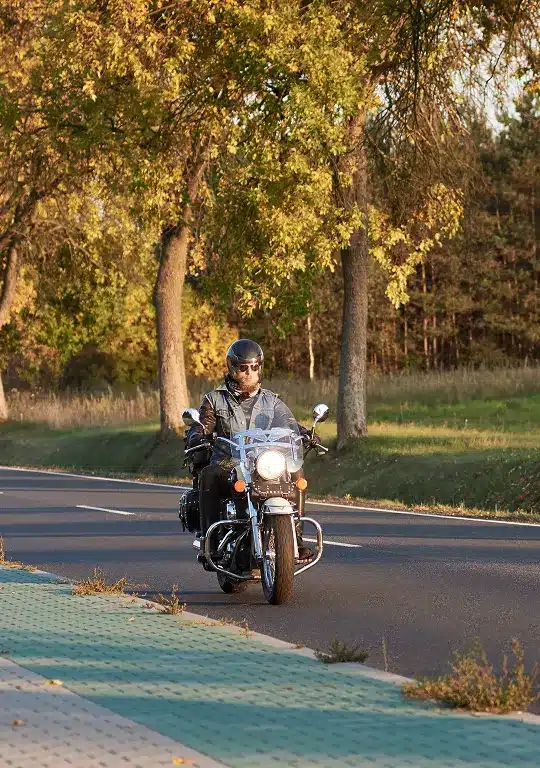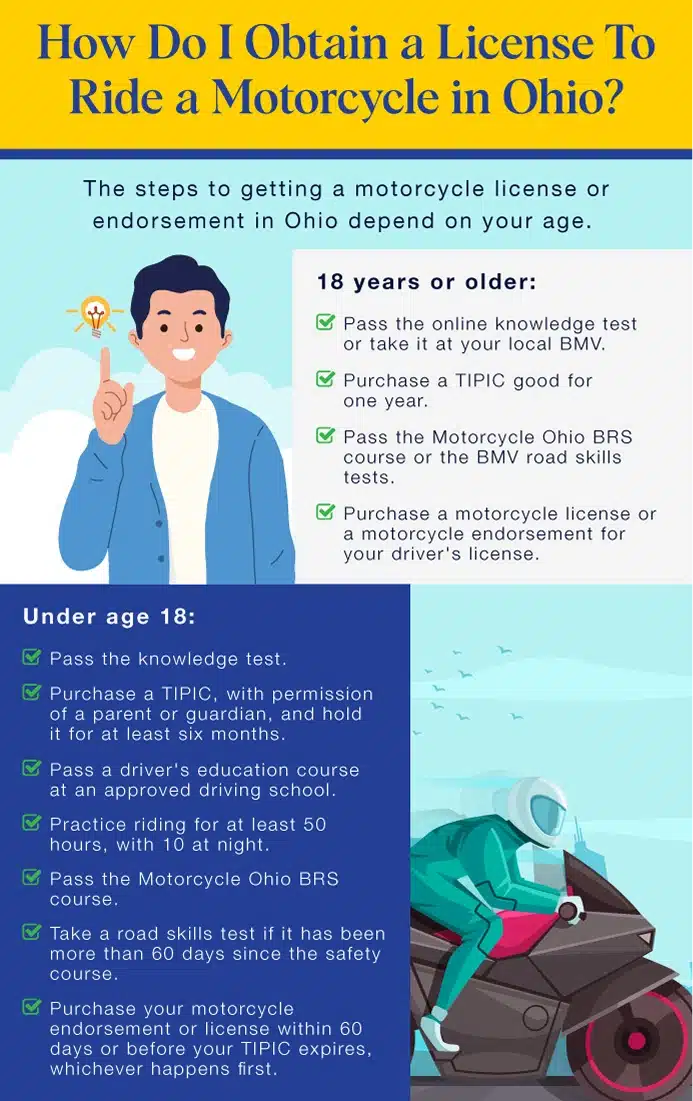A Guide To Ohio’s Motorcycle Laws
Key Takeaways
- Those under 18 must complete additional steps before getting an Ohio motorcycle license.
- All motorcycle riders under 18, permit holders, novice riders, and passengers riding with these groups must wear approved helmets.
- Liability insurance on motorcycles is mandatory to protect others if you cause a crash.
- Motorcyclists must follow the same traffic laws as other vehicles.
- You can file a lawsuit if someone else caused your motorcycle accident and you have damages.
Before you take your motorcycle for a ride in Ohio, you need to understand your legal responsibilities and rights. Use this guide to easily find everything you need to know about Ohio motorcycle laws and what to do in case of an accident. Understand how to get a license, how much insurance you must carry, and which traffic regulations you must follow to stay compliant with the law and safe on the road.
If you were hurt in an incident involving a motorcycle, you may be eligible for significant compensation. Our motorcycle accident lawyers at Lawrence & Associates Accident and Injury Lawyers, LLC, know the state’s laws inside and out. We have experience dealing with insurance companies that don’t want to pay and can assist you in proving liability in a crash that was someone else’s fault.
Who Can Legally Operate a Motorcycle in Ohio?
You must be at least 15 years and 6 months old to start the process of getting an Ohio motorcycle license. Once you pass all requirements, you can get a motorcycle endorsement on your current driver’s license or a standalone motorcycle license if you don’t have a driver’s license.
All riders must first pass a knowledge test to receive a Temporary Instruction Permit Identification Card, or TIPIC, that is valid for one year. Riders holding a TIPIC have riding restrictions, such as not carrying passengers or riding on highways or heavily congested roads.
A Motorcycle Ohio Basic Rider Skills, or BRS, safety course is mandatory for those under 18 and optional for those 18 and older. The last portion of this class is the road skills test. Students who successfully complete it receive a waiver excusing them from the Bureau of Motor Vehicles, or BMV, motorcycle road test. This waiver is only valid for 60 days.
To get started on your Ohio motorcycle license or permit, find your local Ohio BMV. Some services are available online.

How Do I Obtain a License To Ride a Motorcycle in Ohio?
The steps to getting a motorcycle license or endorsement in Ohio depend on your age.
- 18 years or older:
- Pass the online knowledge test or take it at your local BMV.
- Purchase a TIPIC good for one year.
- Pass the Motorcycle Ohio BRS course or the BMV road skills tests.
- Purchase a motorcycle license or a motorcycle endorsement for your driver’s license.
- Under age 18:
- Pass the knowledge test.
- Purchase a TIPIC, with permission of a parent or guardian, and hold it for at least six months.
- Pass a driver’s education course at an approved driving school.
- Practice riding for at least 50 hours, with 10 at night.
- Pass the Motorcycle Ohio BRS course.
- Take a road skills test if it has been more than 60 days since the safety course.
- Purchase your motorcycle endorsement or license within 60 days or before your TIPIC expires, whichever happens first.
After getting a license or endorsement, motorcycle riders of all ages get a novice designation for one year. This designation affects the helmet requirement.

Ohio's Helmet Laws
Under Ohio’s helmet law, certain riders and their passengers must wear approved helmets with chin straps, including:
- All riders under 18
- TIPIC holders
- Novice riders
Even when not required, it is advisable to wear a helmet. According to a 2024 Ohio Traffic Safety Bulletin, over a 5-year period, 71% of motorcyclists who died in accidents and 65% of those seriously injured were not wearing helmets.
Ohio law also requires riders to wear protective eye devices, such as goggles or face shields, unless the motorcycle has a windscreen.
Minimum Insurance Requirements for Riders
Riders must carry Ohio liability insurance minimums that cover bodily injury and property damage. Required coverage includes $25,000 for injury or death of one person, $50,000 for injury or death of 2 or more people, and $25,000 for property damage. You must carry your proof of insurance.
Consider adding uninsured and underinsured motorist coverage in case you are involved in a crash with an uninsured driver or one whose policy limits don’t cover your losses. You can also add MedPay, collision, and other optional coverage.
Driving without insurance carries steep penalties. It can result in loss of your license and registration, fines, and reinstatement fees. You may also have to carry more expensive high-risk insurance for three to five years.
Required Motorcycle Equipment in Ohio
Having the required equipment keeps you in compliance with the law and helps keep you safe. Some mandatory features on motorcycles in Ohio include:
- Headlights: At least one but not more than two
- Red taillight: Must include a braking and stop lamp
- Mirrors: Must have at least one rearview mirror that provides an unobstructed rear view
- Mufflers: Kept in good working order, with baffle plates to cut noise
- Turn signals: Mechanical or electrical turn signals on all bikes manufactured or assembled after January 1, 1968
- Horn: Must be audible for at least 200 feet
There are also requirements specific to passenger safety, including an affixed seat and passenger footrests. The seat must provide enough room so that the driver can operate safely.

Lane Splitting and Traffic Laws
Ohio law does not authorize lane splitting or lane filtering; riders must remain within a single marked lane and follow the same rules of the road as other vehicles. Motorcyclists must observe laws that apply to other vehicles, such as driving in marked lanes. However, two motorcycles are allowed in the same lane.
Motorcyclists must obey all traffic signals and signs, and follow the same rules as cars at intersections and around behaviors such as yielding, passing, and leaving a reasonable distance between vehicles. You can review the rules of the road in the Ohio Driver Manual and the Ohio Motorcycle Operator Manual.
Can You File a Lawsuit After a Motorcycle Accident in Ohio?
If your motorcycle accident was someone else’s fault, you can file an insurance claim, a lawsuit, or both if necessary. Under Ohio’s comparative negligence law, you can only collect compensation if you were 50% or less responsible for the crash. Your percentage of liability reduces your damages proportionately.
For example, if you have $100,000 in damages and were 20% at fault, you can collect $80,000.
You must file your lawsuit within Ohio’s personal injury statute of limitations, which is generally two years from the date of your crash. In most cases, a judge will dismiss your case if you miss the deadline.
You can seek economic and non-economic damages in your lawsuit. Economic damages compensate you for financial losses, such as medical bills, lost wages, and future earning potential. Non-economic damages address your pain, suffering, and emotional harm, such as loss of enjoyment of life.
Motorcycle accidents often involve severe injuries, significant damages, and insurers that fight to limit high payouts. Partner with an experienced Ohio motorcycle accident lawyer who can gather and analyze the evidence necessary to prove the other party’s liability and your harm.
Ohio Motorcycle Resources
There are several resources that new and experienced Ohio motorcyclists can use to learn about licensing, safety, and legal compliance:
- The Ohio BMV provides information about licensing, registration, titles, suspensions, and reinstatements.
- Motorcycle Ohio explains the details of and where to find beginner, intermediate, and advanced rider courses, and provides rider safety resources.
- Ohio Revised Code motorcycle laws dictate who can ride, the necessary equipment, and traffic statutes.

Motorcycle FAQs
Our motorcycle accident lawyers have an in-depth knowledge of motorcycle law in Ohio and are always ready to answer questions. Learn more from our personal injury FAQs page.
Do I Need a Motorcycle License in Ohio?
Yes, you must have a motorcycle license or a motorcycle endorsement on your driver's license. You must carry it with you at all times while riding. You can only ride with a permit for one year.
What To Do After a Motorcycle Accident?
If you are in an accident, get to safety if you can, and call 911. Take pictures and videos of the scene, and collect witness contact information. Seek medical attention, even if you don't think you're seriously hurt, and keep copies of all of your medical records.
Contact our team quickly so we can preserve evidence and build your claim. Please view our case results and client stories to see for yourself our commitment to guiding accident victims toward healing and justice.
What Insurance Coverage Is Required for Motorcycles?
Motorcycles must have the same liability insurance as cars in Ohio. The state requires a minimum of $25,000 for injury or death of one person in an accident, $50,000 for injury or death of 2 or more people, and $25,000 to cover property damage. You must carry proof of insurance.
Is Lane Splitting Allowed in Ohio?
You cannot split or filter lanes of moving or stopped traffic. Motorcyclists must stay in their lane unless they are passing another vehicle, and they must follow the same rules as other motor vehicles.